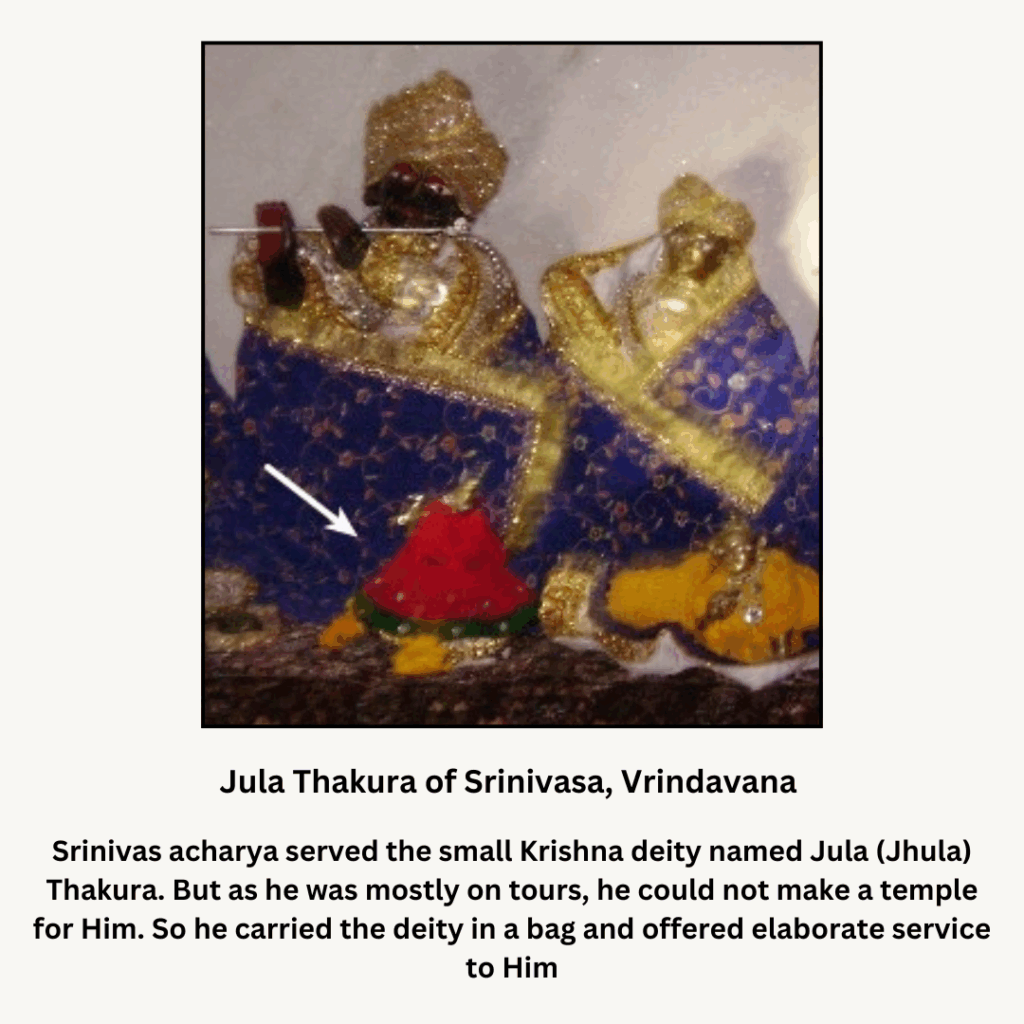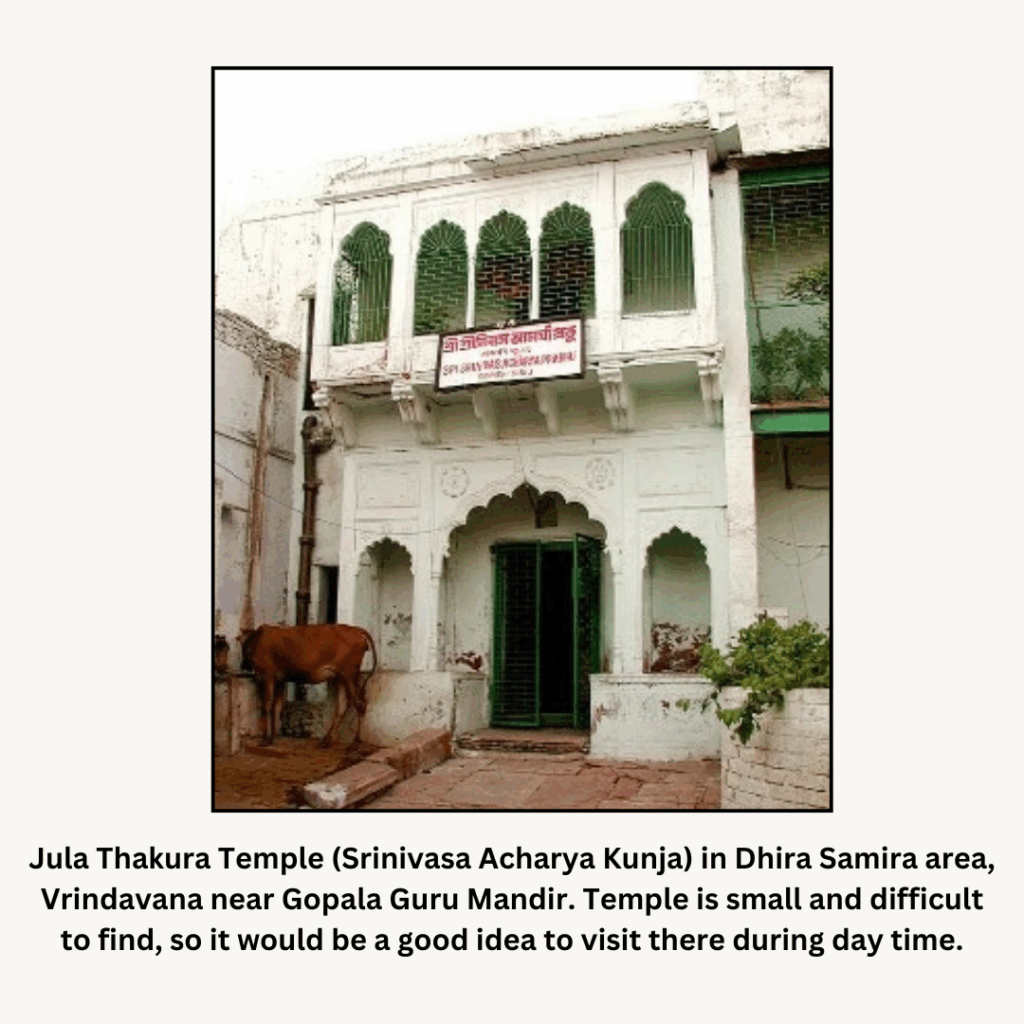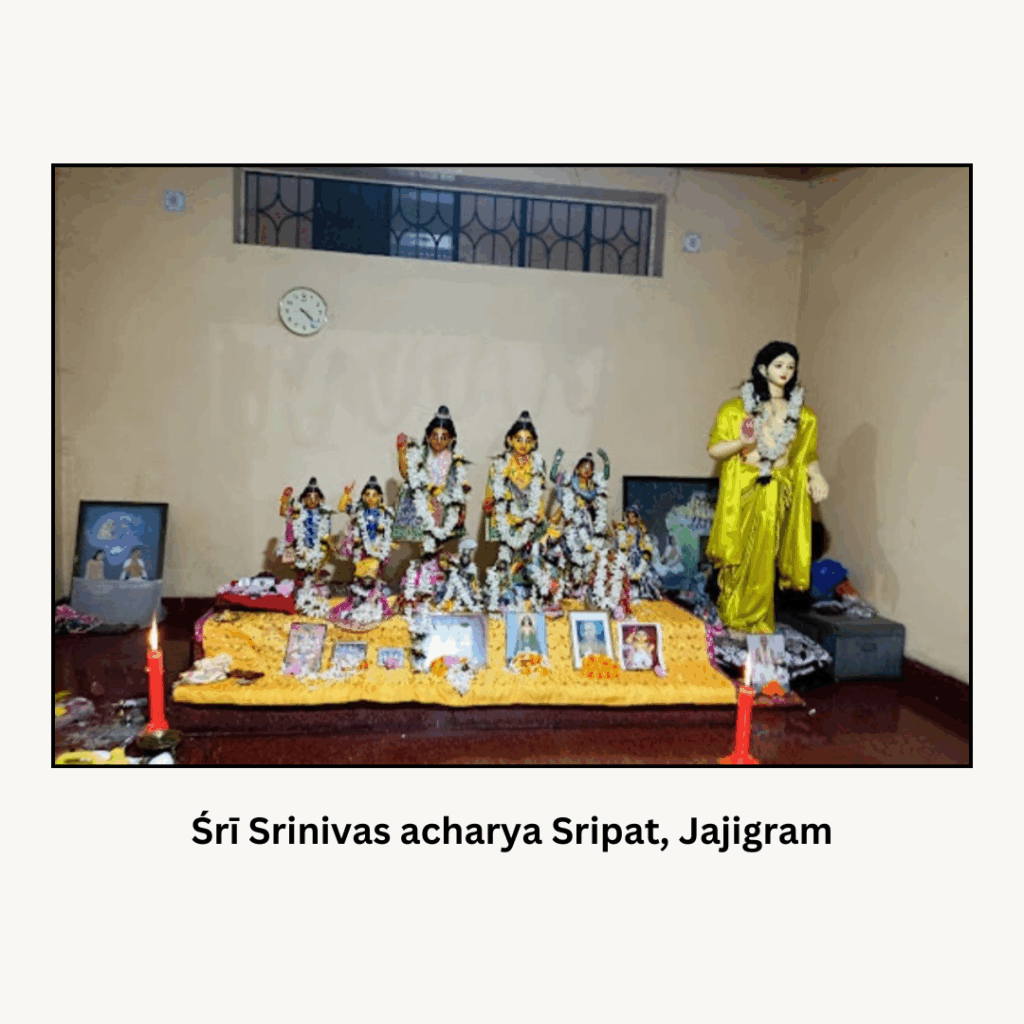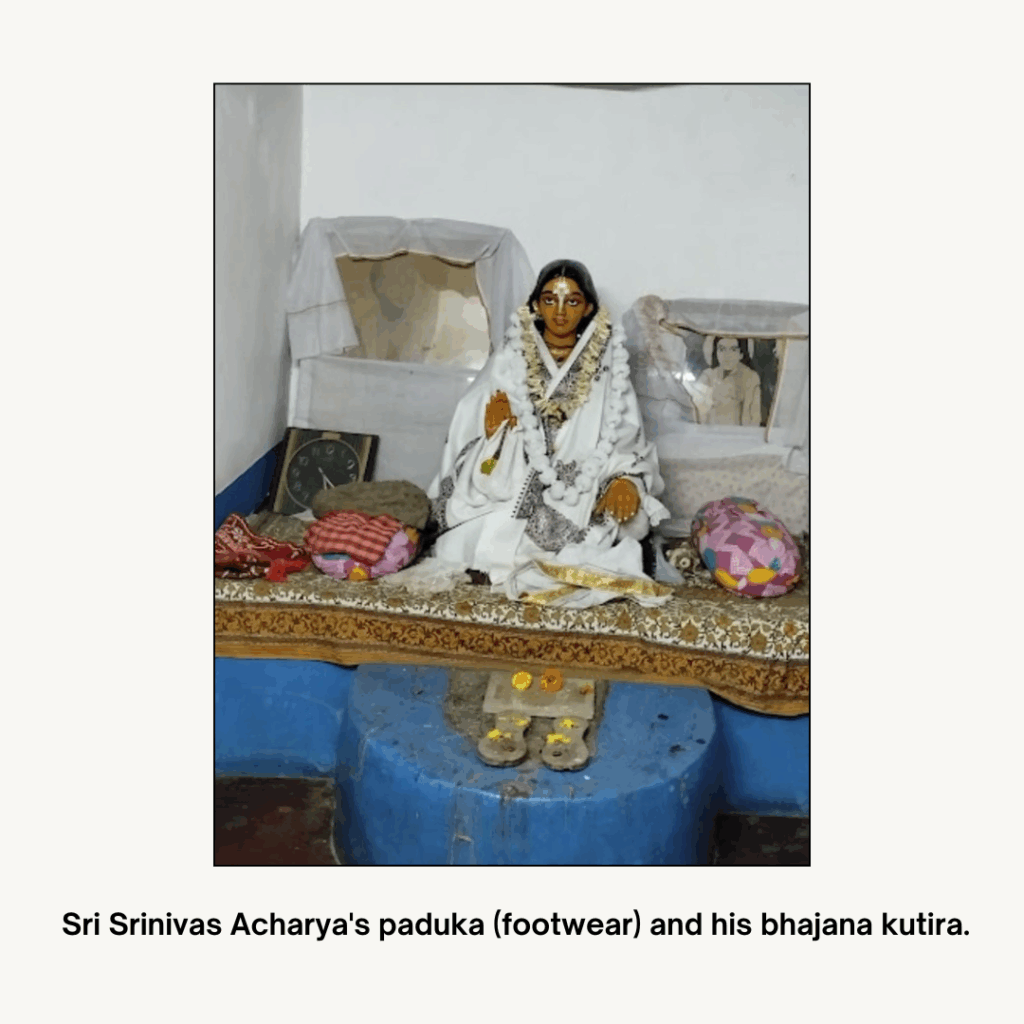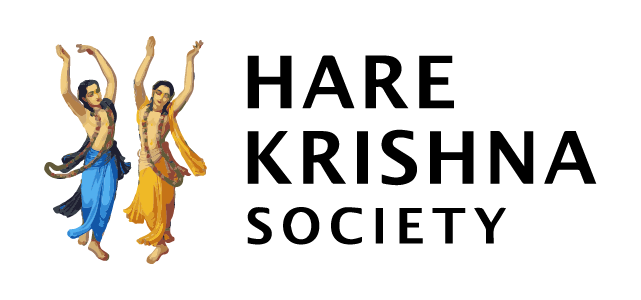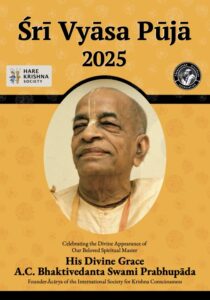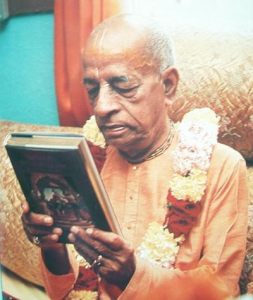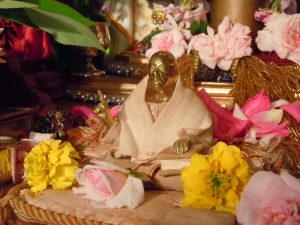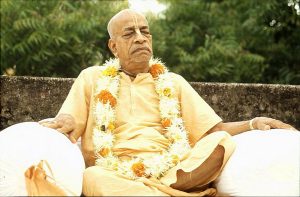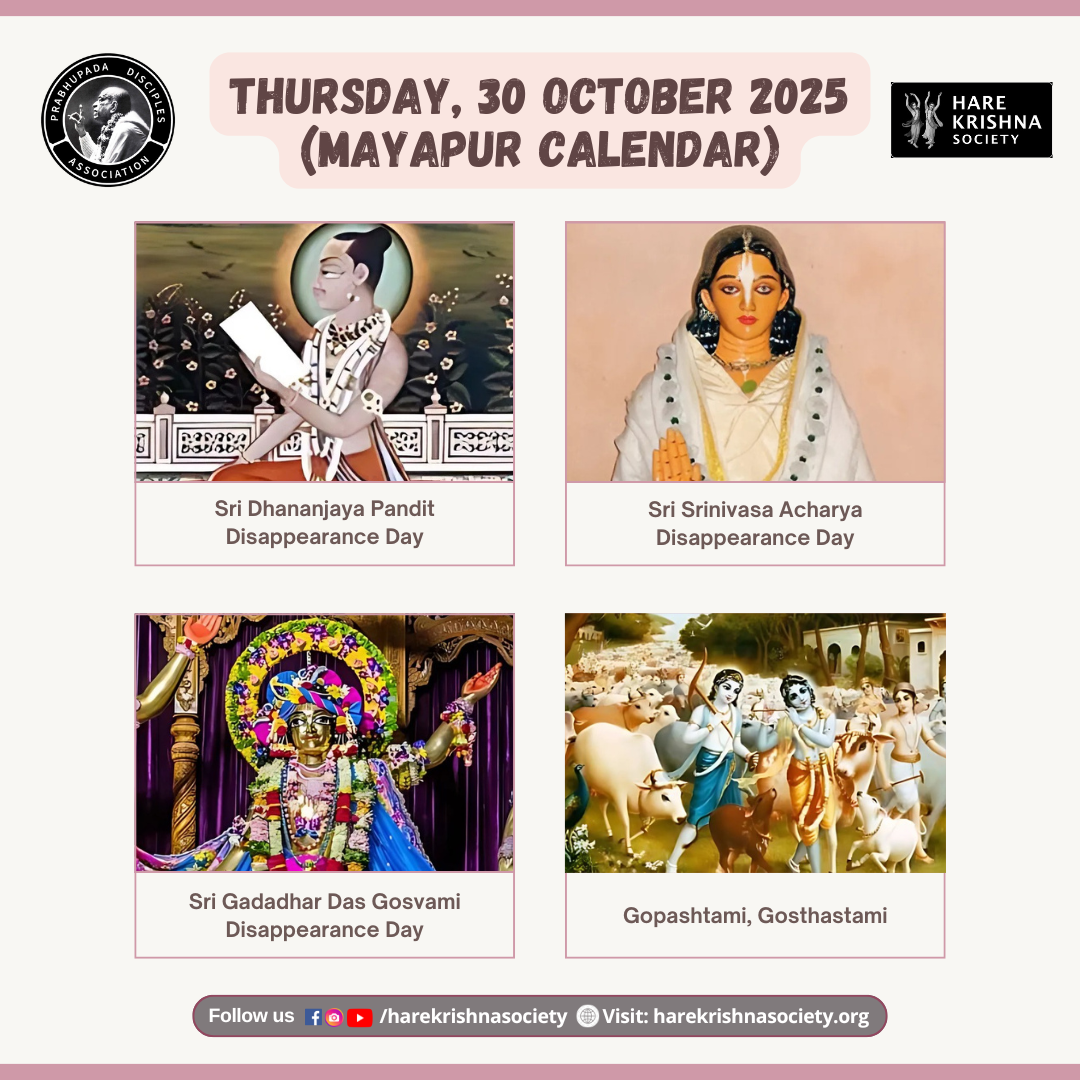
Thursday, 30 October 2025 [Mayapur, West Bengal, India Time]
● Śrī Dhanañjaya Paṇḍita Disappearance Day
● Śrī Śrīnivāsa Ācārya Disappearance Day
● Śrī Gadādhara Dāsa Gosvāmī Disappearance Day
● Gopāṣṭamī, Gosthaṣṭamī
● Śrī Dhanañjaya Paṇḍita Disappearance Day
“The sixteenth dear servant of Nityānanda Prabhu was Dhanañjaya Paṇḍita. He was very much renounced and always merged in love of Kṛṣṇa.”
(Śrī Caitanya-caritāmṛta >> Ādi-līlā 11.31)
“Paṇḍita Dhanañjaya was a resident of the village in Katwa named Śītala. He was one of the twelve gopālas. His former name, according to the Gaura-gaṇoddeśa-dīpikā, was Vasudāma. Śītala-grāma is situated near the Maṅgalakoṭa police station and Kaicara post office in the district of Burdwan. On the narrow railway from Burdwan to Katwa is a railway station about nine miles from Katwa known as Kaicara. One has to go about a mile northeast of this station to reach Śītala. The temple was a thached house with walls made of dirt. Some time ago, the zamindars of Bājāravana Kābāśī, the Mulliks, constructed a big house for the purpose of a temple, but for the last sixty-five years the temple has been broken down and abandoned. The foundation of the old temple is still visible. There is a tulasī pillar near the temple, and every year during the month of January the disappearance day of Dhanañjaya is observed. It is said that for some time Paṇḍita Dhanañjaya was in a saṅkīrtana party under the direction of Śrī Caitanya Mahāprabhu, and then he went to Vṛndāvana. Before going to Vṛndāvana, he lived for some time in a village named Sāṅcaḍāpāṅcaḍā, which is six miles south of the Memārī railway station. Sometimes this village is also known as ‘the place of Dhanañjaya’ (Dhanañjayera Pāṭa). After some time, he left the responsibility for worship with a disciple and went back to Vṛndāvana. After returning from Vṛndāvana to Śītala-grāma, he established a Deity of Gaurasundara in the temple. The descendants of Paṇḍita Dhanañjaya still live in Śītala-grāma and look after the temple worship.”
(Excerpt from Śrīla Prabhupāda Purport on Srī Caitanya-caritāmṛta, Ādi-līlā 11.31)
● Śrī Śrīnivāsa Ācārya Disappearance Day
“It is said that Abhirāma Ṭhākura had a whip and that whoever he touched with it would immediately become an elevated devotee of Kṛṣṇa. Among his many disciples, Śrīmān Śrīnivāsa Ācārya was the most famous and the most dear, but it is doubtful that he was his initiated disciple.”
(Excerpt from Śrīla Prabhupāda Purport on Śrī Caitanya-caritāmṛta, Ādi-līlā 11.13).
“When Śrīnivāsa Ācārya went to see Raghunātha dāsa Gosvāmī, the Gosvāmī blessed him by embracing him. Śrīnivāsa Ācārya requested his blessings for preaching in Bengal, and Śrīla Raghunātha dāsa Gosvāmī granted them.”
(Excerpt from Śrīla Prabhupāda Purport on Śrī Caitanya-caritāmṛta, Ādi-līlā 10.91)
“Śrīla Gopāla Bhaṭṭa Gosvāmī compiled a book called Sat-kriyā-sāra-dīpikā, edited the Hari-bhakti-vilāsa, wrote a forword to the Ṣaṭ-sandarbha and a commentary on the Kṛṣṇa-karṇāmṛta, and installed the Rādhāramaṇa Deity in Vṛndāvana. In the Gaura-gaṇoddeśa-dīpikā, verse 184, it is mentioned that his previous name in the pastimes of Lord Kṛṣṇa was Anaṅga-mañjarī. Sometimes he is also said to have been an incarnation of Guṇa-mañjarī. Śrīnivāsa Ācārya and Gopīnātha Pūjārī were two of his disciples.
(Excerpt from Śrīla Prabhupāda Purport on Śrī Caitanya-caritāmṛta, Ādi-līlā 10.105)
● Śrī Gadādhara Dāsa Gosvāmī Disappearance Day
“Śrī Gadādhara dāsa, the twenty-third branch, was understood to be the topmost, for he induced all the Muslim Kazis to chant the holy name of Lord Hari.”
(Śrī Caitanya-caritāmṛta, Ādi-līlā 10.53)
“About eight or ten miles from Calcutta, on the banks of the Ganges, is a village known as Eṅḍiyādaha-grāma. Śrīla Gadādhara dāsa was known as an inhabitant of this village (eṅḍiyādaha-vāsī gadādhara dāsa). The Bhakti-ratnākara Seventh Chapter, informs us that after the disappearance of Lord Caitanya Mahāprabhu, Gadādhara dāsa went from Navadvīpa to Katwa. Thereafter he came to Eṅḍiyādaha and resided there. He is stated to be the luster of the body of Śrīmatī Rādhārāṇī, just as Śrīla Gadādhara Paṇḍita Gosvāmī is an incarnation of Śrīmatī Rādhārāṇī Herself. Caitanya Mahāprabhu is sometimes explained to be rādhā-bhāva-dyuti-suvalita, or characterized by the emotions and bodily luster of Śrīmatī Rādhārāṇī. Gadādhara dāsa is this dyuti, or luster. In the Gaura-gaṇoddeśa-dīpikā he is described to be the expansion potency of Śrīmatī Rādhārāṇī. He counts among the associates of both Śrīla Gaurahari and Nityānanda Prabhu; as a devotee of Śrī Caitanya Mahāprabhu he was one of the associates of Lord Kṛṣṇa in conjugal love, and as a devotee of Lord Nityānanda he is considered to have been one of the friends of Kṛṣṇa in pure devotional service. Even though he was an associate of Lord Nityānanda Prabhu, he was not among the cowherd boys but was situated in the transcendental mellow of conjugal love. He established a temple of Śrī Gaurasundara in Katwa.
In 1434 Śakābda (1534 A.D.), when Lord Nityānanda Prabhu was empowered by Lord Caitanya to preach the saṅkīrtana movement in Bengal, Śrī Gadādhara dāsa was one of Lord Nityānanda’s chief assistants. He preached the saṅkīrtana movement by requesting everyone to chant the Hare Kṛṣṇa mahā-mantra. This simple preaching method of Śrīla Gadādhara dāsa can be followed by anyone and everyone in any position of society. One must simply be a sincere and serious servant of Nityānanda Prabhu and preach this cult door to door.
When Śrīla Gadādhara dāsa Prabhu was preaching the cult of hari-kīrtana, there was a magistrate who was very much against his saṅkīrtana movement. Following in the footsteps of Lord Caitanya Mahāprabhu, Śrīla Gadādhara dāsa one night went to the house of the Kazi and requested him to chant the Hare Kṛṣṇa mahā-mantra. The Kazi replied, “All right, I shall chant Hare Kṛṣṇa tomorrow.” On hearing this, Śrīla Gadādhara dāsa Prabhu began to dance, and he said, “Why tomorrow? You have already chanted the Hare Kṛṣṇa mantra, so simply continue.”
In the Gaura-gaṇoddeśa-dīpikā it is said:
rādhā-vibhūti-rūpā yā candrakāntiḥ purā vraje
sa śrī-gaurāṅga-nikaṭe dāsa-vaṁśyo gadādharaḥ
pūrṇānandā vraje yāsīd baladeva-priyāgraṇī
sāpi kārya-vaśād eva prāviśat taṁ gadādharam
Śrīla Gadādhara dāsa is considered to be a united form of Candrakānti, who is the effulgence of Śrīmatī Rādhārāṇī, and Pūrṇānandā, who is an expansion of Lord Balarāma’s very dear girl friend. Thus Śrīla Gadādhara dāsa Prabhu was one of the associates of both Caitanya Mahāprabhu and Nityānanda Prabhu.
Once while Śrīla Gadādhara dāsa Prabhu was returning to Bengal from Jagannātha Purī with Nityānanda Prabhu, he forgot himself and began talking very loudly as if he were a girl of Vrajabhūmi selling yogurt, and Śrīla Nityānanda Prabhu noted this. Another time, while absorbed in the ecstasy of the gopīs, he carried a jug filled with Ganges water on his head as if he were selling milk. When Lord Caitanya Mahāprabhu appeared in the house of Rāghava Paṇḍita while going to Vṛndāvana, Gadādhara dāsa went to see Him, and Śrī Caitanya Mahāprabhu was so glad that He put His foot on his head. When Gadādhara dāsa Prabhu was present in Eṅḍiyādaha, he established a BālaGopāla mūrti for worship there. Śrī Mādhava Ghoṣa performed a drama known as “Dāna-khaṇḍa” with the help of Śrī Nityānanda Prabhu and Śrī Gadādhara dāsa. This is explained in the Caitanya-bhāgavata, Antya-khaṇḍa, Fifth Chapter.
The tomb of Gadādhara dāsa Prabhu, which is in the village of Eṅḍiyādaha, was under the control of the Saṁyogī Vaiṣṇavas and later under the direction of Siddha Bhagavān dāsa Bābājī of Kālnā. By his order, Śrī Madhusūdana Mullik, one of the members of the aristocratic Mullik family of the Nārikelaḍāṅgā in Calcutta, established a pāṭavātī (monastery) there in the Bengali year 1256. He also arranged for the worship of a Deity named Śrī Rādhākānta. His son Balāicāṅda Mullik established Gaura-Nitāi Deities there in the Bengali year 1312. Thus on the throne of the temple are both Gaura-Nityānanda Deities and Rādhā-Kṛṣṇa Deities. Below the throne is a tablet with an inscription written in Sanskrit. In that temple there is also a small Deity of Lord Śiva as Gopeśvara. This is all described on a stone by the side of the entrance door.”
(Srila Prabhupada Purport on Śrī Caitanya-caritāmṛta, Ādi-līlā 10.53)
● Gopāṣṭamī, Gosthaṣṭamī
On this day lord Shri Krishna became a qualified cowherd. Before this day, he was a keeper of the calves.
“In this way, Śrī Kṛṣṇa, along with His elder brother Balarāma, passed the childhood age known as kaumāra and stepped into the age of paugaṇḍa, from the sixth year up to the tenth. At that time, all the cowherd men conferred and agreed to give those boys who had passed their fifth year charge of the cows in the pasturing ground. Given charge of the cows, Kṛṣṇa and Balarāma traversed Vṛndāvana, purifying the land with Their footprints”
(Excerpt from KṚṢṆA, The Supreme Personality of Godhead, Chapter 15)
“Kāliya was residing within the water of the Yamunā, and as a result the back portion of that river had become poisoned. Thus so many cows who had drunk the water had died. Therefore Kṛṣṇa, even though He was only four or five years old, dipped Himself into the water, punished Kāliya very severely and then asked him to leave the place and go elsewhere.
Kṛṣṇa said at that time that the cows are worshiped even by the demigods, and He practically demonstrated how to protect the cows. At least people who are in Kṛṣṇa consciousness should follow in His footsteps and give all protection to the cows. Cows are worshiped not only by the demigods. Kṛṣṇa Himself worshiped the cows on several occasions, especially on the days of Gopāṣṭamī and Govardhana-pūjā.”
(Excerpt from The Nectar of Devotion, Chapter 21)
[Note: All the Above quotes are from the original first edition books of Śrīla Prabhupāda]
